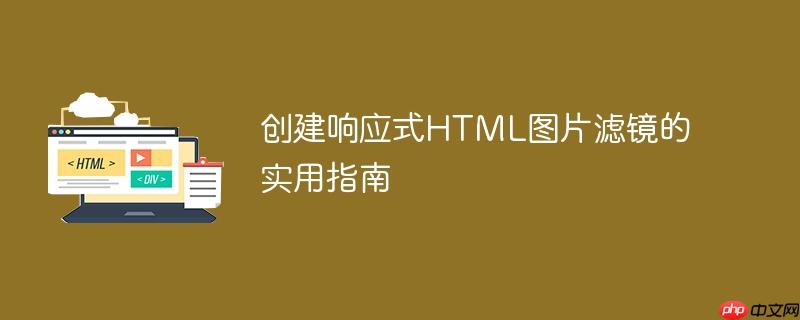
本文将指导你如何为响应式html图片添加滤镜效果,同时保持图片响应性、alt文本可用性、边框以及标题和副标题的正确显示。我们将探讨使用css Filter属性以及伪元素来实现这一目标,并提供代码示例和注意事项,帮助你轻松实现图片滤镜效果,避免常见的布局问题。
使用CSS Filter属性
最直接的方式是使用CSS的filter属性。这个属性允许你对元素应用各种视觉效果,例如模糊、对比度、亮度、灰度、反转、色相旋转、透明度等等。
示例代码:
.img-fit { width: 100%; height: 100%; Object-fit: cover; z-index: 0; } .img-fit:hover { filter: invert(100%); /* 反转颜色 */ transition: .3s; /* 添加过渡效果 */ }
这段代码会在鼠标悬停在图片上时,反转图片的颜色,并添加一个平滑的过渡效果。
常用Filter属性值:
- blur(px): 模糊效果,px值越大越模糊。
- brightness(%): 调整亮度,100%为原始亮度,大于100%更亮,小于100%更暗。
- contrast(%): 调整对比度,100%为原始对比度,大于100%对比度更高,小于100%对比度更低。
- grayscale(%): 转换为灰度图像,100%为完全灰度。
- invert(%): 反转颜色,100%为完全反转。
- opacity(%): 调整透明度,0%为完全透明,100%为完全不透明。
- sepia(%): 转换为棕褐色调。
- saturate(%): 调整饱和度。
- hue-rotate(deg): 调整色相。
- drop-shadow(h-shadow v-shadow blur spread color): 添加阴影。
你可以在W3Schools上找到各种filter属性值的演示。
使用伪元素实现背景颜色滤镜
如果你需要一个背景颜色叠加的滤镜效果,可以使用伪元素:before或:after。这种方法允许你在图片上方或下方创建一个图层,并设置其背景颜色和透明度。
示例代码:
.flex-div { position: relative; /* 关键:设置相对定位 */ flex-basis: 30%; border: 8px solid black; background-color: rgba(255, 127, 80, 0.532); height: 40vh; margin: 4vh; z-index: 1; overflow: hidden; /* 避免伪元素超出容器 */ } .flex-div::before { content: ""; position: absolute; top: 0; left: 0; width: 100%; height: 100%; background-color: rgba(255, 0, 0, 0.5); /* 红色半透明背景 */ z-index: 1; /* 确保在图片上方 */ pointer-events: none; /* 允许点击穿透 */ } .img-fit { width: 100%; height: 100%; object-fit: cover; z-index: 0; /* 确保在伪元素下方 */ } .title { position: absolute; /* 修改为绝对定位 */ bottom: 15vh; left: 2vh; /* 修改为left,更易于控制位置 */ padding: 0 2vh 0 2vh; color: wheat; background-color: rgb(0, 0, 0); z-index: 2; /* 确保在伪元素上方 */ } .portfolio-tools { position: absolute; /* 修改为绝对定位 */ bottom: 10vh; right: 2vh; /* 修改为right,更易于控制位置 */ padding: 0 2vh 0 2vh; color: white; z-index: 2; /* 确保在伪元素上方 */ }
HTML结构:
<section class="flex-section"> <div class="flex-div"> <img class="img-fit" src="https://ichef.bbci.co.uk/news/976/cpsprodpb/C9F6/production/_118720715_gettyimages-51246880.jpg" alt="I need to have an alt for this image, so I can't just make it a CSS background-image"> <h1 class="title">.title 1</h1> <p class="portfolio-tools">.portfolio-tools</p> </div> </section>
关键点:
- position: relative;: flex-div需要设置为position: relative;,这样伪元素才能相对于它进行定位。
- position: absolute;: 伪元素需要设置为position: absolute;,以便覆盖整个容器。
- z-index: 使用z-index控制图层顺序,确保伪元素在图片上方,文字在伪元素上方。
- pointer-events: none;: 设置伪元素的pointer-events: none;,允许用户点击穿透伪元素,与下方的图片进行交互(例如,链接)。
- 标题和副标题的定位: 将.title和.portfolio-tools的定位方式改为position: absolute;,并使用left和right属性来精确控制它们的位置,而不是使用bottom和right以及相对定位。
注意事项和总结
- 响应式设计: 确保你的图片和容器都是响应式的,可以使用object-fit: cover;来使图片填充容器,并保持宽高比。
- 性能: 过多的滤镜效果可能会影响性能,特别是移动设备上。尽量减少不必要的滤镜效果。
- 可访问性: 始终为<img>标签提供有意义的alt属性,这对于屏幕阅读器和搜索引擎至关重要。
- 图层控制: 使用z-index属性来控制元素的堆叠顺序,确保滤镜、图片和文字按照预期显示。
- 避免过度使用: 滤镜效果虽然可以增强视觉效果,但过度使用可能会分散用户的注意力,影响用户体验。
通过结合filter属性和伪元素,你可以灵活地为响应式HTML图片添加各种滤镜效果,同时保持良好的用户体验和可访问性。 记住,最佳实践是根据具体需求选择合适的方法,并始终关注性能和可访问性。


评论(已关闭)
评论已关闭